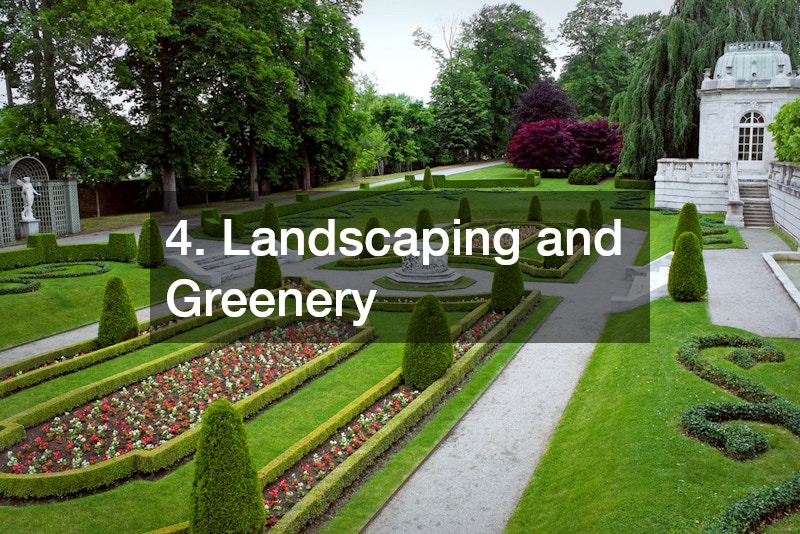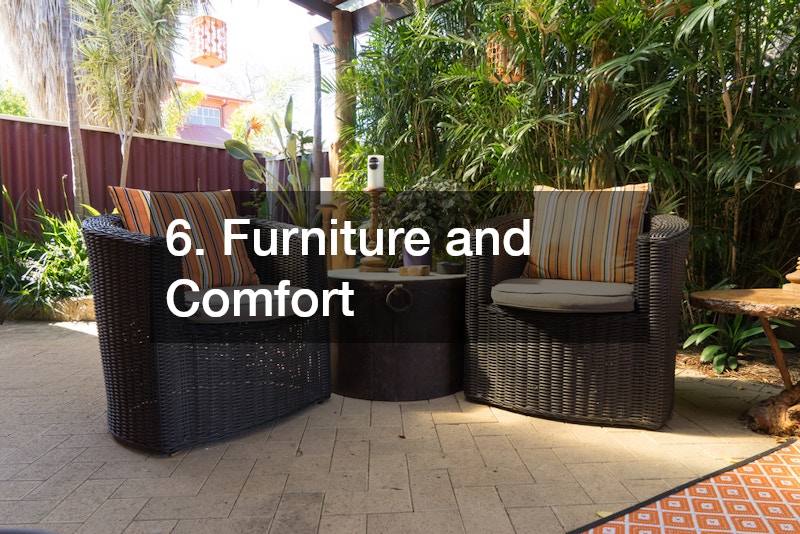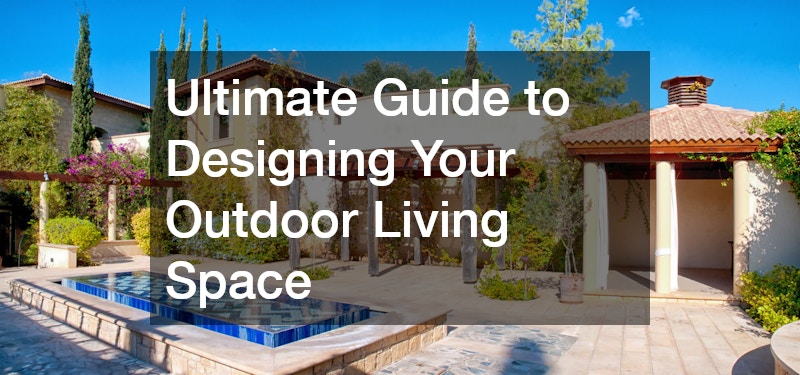It is rewarding to design an outdoor living area that will enhance the value of your home and your quality of life. Planning is key, whether you are creating a relaxing retreat, an entertaining area, or a family-friendly backyard. Here are some considerations that will guide you in creating a beautiful and functional outdoor living area.
1. Assess Your Space
Start by assessing your outdoor space before you start designing. Understanding the size and shape of your outdoor space and its existing features will allow you to make informed decisions.
Assess the Terrain
To fully understand your terrain, you should examine the natural layout. Take note of slopes and flat areas. Also, take into account any existing vegetation. This information not only guides the placement of different elements but will also inform you on how to manage drainage and ensure soil stability.
Key Features to Identify
You can identify any features that you would like to highlight or keep, such as matured trees, unique landscape elements, or views. Incorporating landscape design principles into your outdoor living area is essential. Consider how the features you choose will affect your outdoor living space’s overall aesthetics and functionality. Assess any areas that need to be addressed, like low spots where water collects or poor soil.
Consider Accessibility
Consider how you, your family, and guests will use the outdoor area from your home. Plan for smooth transitions and ensure that the pathways are wide and clear for everyone to use, even those with mobility issues. If necessary, consider incorporating ramps or gently sloped areas to improve accessibility.
2. Climate and Weather
The local climate and weather patterns are important factors in the design of an outdoor living area. These factors will affect your choice of plants, materials, and other features.
Sun and Shade
Analyze sun and shade patterns during the day and in different seasons. You can then position plants, seating areas, and shade structures accordingly. You might, for example, want to have a shady dining area on hot afternoons and a sunny place for your morning coffee.
Wind and Rain
Consider the wind direction and rainfall average. Windbreaks such as screens or hedges can help create a more pleasant environment. Proper drainage systems will also prevent water from pooling and damaging your area.
Extreme Temperature
Plan for extreme temperatures in your area. It could be incorporating elements such as water features and shade structures in hot climates or planning for snow and ice control in colder regions.
3. Zoning and Layout
An organized layout is both functional and attractive. Divide your space according to activities and make it more functional.
Activity Zones
Determine the activities that you would like to accommodate. For example, dining, relaxing, cooking, gardening, or playing. To avoid clutter and improve usability, create separate zones for each activity.
Flow and Connectivity
Ensure a smooth flow between zones. Transitions and pathways should be visually appealing and logical. Use materials and design elements to create a consistent look and feel in your outdoor space.
Scale and Proportion
When planning your layout, keep an eye on balance and proportion. Make sure that the furniture and structures you choose are sized appropriately for your space. A crowded area can feel claustrophobic, and too much space can appear empty.
4. Landscaping and Greenery

Greenery and plants are essential to outdoor spaces. They provide beauty, shade, and a connection with nature. Professional landscape designers can improve the design and functionality of an area through thoughtful landscaping.
Plant Selection
Select plants that suit your soil and climate. Native plants can be the best option as they are less maintenance-intensive and more resistant to pests and disease. To improve plant growth, amend the soil with topsoil from your area to increase water retention and provide vital nutrients. Consult experts to determine what type of soil amendments are needed for the specific area you plan to plant. They can give you valuable insight into the soil composition and pH level so that your plants will thrive in their new environment.
Layering and Texture
Include a variety of plants that are different in height, texture, and color to create visual interest. By layering plants, you can create depth and dimension in your landscape. Low-growing groundcovers like creeping thyme complement medium-sized shrubs like lavender and lead up to taller Japanese maples. This creates a layered aesthetic that enhances your outdoor space.
Seasonal Interest
Consider a variety of plants to add year-round interest to your outdoor space when planning seasonal interest. Evergreens are structurally sound and keep their color all year round, providing a background for seasonal displays. Tulips and daffodils are spring bulbs that burst into color early, signaling the coming of spring. Perennials like black-eyed Susans and hydrangeas attract pollinators and produce vibrant blooms during the warmer months. Add trees and shrubs with striking fall foliage, such as maples or Birches, to your garden as the temperatures begin to cool.
5. Hardscaping Elements
Hardscaping is the term used to describe all non-plant elements in your outdoor space. This includes patios, walkways, and decorative structures. These elements define and provide structure to different areas. Consult a contractor for the installation of hardscaping to ensure that it is integrated with your landscape design.
Patios and Decks
Patios and decks can be used to create comfortable dining and seating areas. Select durable and weather-resistant materials such as stone, concrete, or composite decking. Be sure to consider the shape and size of these areas so that they are well-suited for the overall design. Hiring patio and deck builders to install your deck or patio will ensure a professional job and compliance with local building codes.
Walkways and Pathways
The aesthetics of your outdoor space is enhanced by well-designed pathways and walkways. Materials such as brick pavers or stamped concrete can be used to complement the architecture of your home and its overall design. Integrating lighting along pathways and walkways enhances safety, adds ambiance, and allows you to enjoy your outdoor space day and night.
Retaining Walls and Borders
Create defined planting beds by using retaining walls or borders. These structures can be used as decorative elements or seating. Select materials that will blend seamlessly with the other hardscaping features.
6. Furniture and Comfort

The right furniture will help you create a welcoming and comfortable outdoor space. You should choose furniture that reflects your style, your needs, and the intended purpose of the outdoor space.
Durability and Weather Resistance
For comfort and longevity, it is important to choose outdoor furniture that can endure different weather conditions. Materials that are known for their durability include teak, aluminum, or wrought iron. Weather-resistant wicker is also a good choice. These materials have a reputation for being resistant to moisture, UV rays, and temperature changes, so they will remain in good shape over time. Furniture finishing services can be used to add protective treatments or coatings that will enhance the durability and weather resistance of your outdoor furniture.
Choose fabrics and cushions that are resistant to fading mold and mildew, such as Sunbrella. This will ensure that your outdoor furniture remains attractive and comfortable despite the weather.
Comfort and Functionality
Comfort enhances the enjoyment of your outdoor space. Furniture with ergonomic designs will provide support and promote relaxation. Multifunctional furniture can maximize your space and function. Benches with storage compartments provide a convenient place to store cushions, blankets, or outdoor toys. Tables with adjustable or extendable heights can accommodate a variety of activities and large gatherings. This will enhance the versatility of your outdoor space.
7. Lighting
Lighting your outdoor area properly extends its use into the evening and creates an ambiance. Well-designed lighting enhances safety, aesthetics, and functionality. Don’t be afraid to consult a lighting contractor when designing your outdoor lighting plan. They can guide you in choosing the best fixtures, placements, and techniques for your lighting scheme while also ensuring compliance with local laws and regulations.
Task Lighting
Install task lighting where you perform specific activities, like cooking, dining, and pathways. These functional areas require bright, focused lighting.
Ambient Lighting
Ambient lighting can create a cozy, warm atmosphere. String lights, wall sconces, and lanterns can be used to create a warm, inviting atmosphere.
Accent Lighting
Accent lighting can be used to highlight architectural features, such as trees, water elements, and architectural details. Accent lighting can be used to draw attention to focal points in your space.
8. Storage Solutions
Keep your outdoor area clutter-free and organized with effective storage solutions. Plan to create a functional and attractive area by incorporating storage.
Built-in Storage
Integrate built-in storage into your outdoor area to maximize functionality and organization. Built-in storage solutions can be used for both seating and serving, maximizing the space available in your outdoor living area. Think about benches that have hidden compartments to store outdoor toys or cushions or cabinets and storage boxes integrated into the design of your deck or patio.
Sheds and Outbuildings
Consider adding an outbuilding or shed to your outdoor area if you need more storage. A shed builder can help you choose a style that will complement your landscape and home. Make sure the shed design allows for easy access to all outdoor tools, seasonal items, and equipment. A well-designed shed will not only improve functionality but will also enhance the aesthetics and organization of your outdoor space.
Creative Solutions
When it comes to outdoor storage, think outside of the box. Use decorative containers as planters and seating to maximize both aesthetics and functionality. Use under-deck storage for large items such as gardening tools or cushions for outdoor furniture. They will be out of sight but still easily accessible. Install wall-mounted hooks or racks to hang bicycles, hoses, and gardening tools. This will free up valuable space on the floor while maintaining an organized environment.
9. Outdoor Dining and Cooking
A dining and cooking area in your backyard can be a great addition to your home. Planning ensures that these areas are convenient, functional, and enjoyable.
Outdoor Kitchens
Add an outdoor kitchen that includes appliances such as a sink, grill, and refrigerator. Materials that are resistant to the elements, such as stone, stainless steel, or concrete, can be used. Outdoor kitchen companies are able to provide invaluable expertise when it comes to designing layouts that work and choosing high-quality materials and appliances.
Dining Areas
Create a dining area that is comfortable with a table and chairs made of sturdy materials. It should be placed close to the kitchen area but still with plenty of space for socializing and easy movement.
Shade and Shelter
You can provide shade and shelter to your dining area by using umbrellas, pergolas, or retractable awnings. This will make the area more versatile in all weather conditions, and it will also add to your guests’ comfort.
10. Privacy and Screening
Screening and privacy are key to creating a private and comfortable outdoor living area. They can reduce noise and block unwanted views, improving your enjoyment of your outdoor space.
Fencing and Walls
Create a physical barrier by building a fence or wall between your property and the neighboring property. Select materials that complement your home and offer the desired privacy. A professional fence installation can be assured by hiring a reputable fence company.
Plants and Hedges
Plants and hedges can be used as natural screens. Use evergreens and tall ornamental grasses to create effective and attractive privacy solutions.
Decorative Screens
Include decorative screens made of wood, metal, or composite. They can be used to add design while also serving a purpose.
Key Takeaways
To create a functional, comfortable, and beautiful outdoor living area, you must carefully consider a variety of factors. You can create a space that is both functional and comfortable by evaluating your outdoor living area, understanding the climate, and planning your layout. Incorporating features like furniture, lighting, storage solutions, and privacy-enhancing features will enhance your enjoyment of this space. A well-designed outdoor area can enhance your lifestyle, whether you are entertaining guests, enjoying time with the family, or looking for a quiet retreat.

